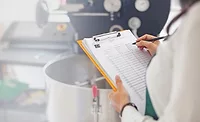Food Safety
Pests can shut you down

|
| Sanitation, exclusion and building maintenance can be combined with fly lights, air curtains, insect growth regulators, pheromone traps and other tools to avoid the need for chemical treatment. Source: McCloud Services. |
A food shall be deemed to be adulterated if it consists in whole or in part of any filthy, putrid or decomposed substance, or if it is unfit for food; or if it has been prepared, packed, or held under insanitary conditions whereby it may have become contaminated with filth, or whereby it may have been rendered injurious to health.
An integrated pest control program is a must for any food processor. It should include the design and maintenance of buildings, grounds and equipment; a sanitation program that ensures a clean, well-maintained facility and does all it can to eliminate any sources of food and moisture that might attract pests, as well as potential harborage sites; a monitoring program that tracks the presence of flying and crawling insects, rodents and other pests; and a corrective action program designed to be implemented when monitoring indicates an increase in pest activity.
Processors should work with experts (pest control operators or PCOs) to ensure their program is properly designed to monitor and control pests unique to where the plant is located. For example, a facility in the tropics might need to focus on not only insects and rodents, but also lizards. In addition, processors should develop a close working relationship with the PCO. They also should properly educate plant personnel on pest management, specifically covering why the program has been developed and holding regular meetings to evaluate how the program is working. Processors also should ensure the PCO performs the proper in-plant work and meets with plant staff after each visit to discuss what was observed during that visit.
Although many processors rely on a PCO to establish a pest management program and develop the contract under which it works, they should instead give the PCO a list of what is expected from their pest management program. The program should include basic expectations for services including monitoring, recordkeeping, verification and corrective actions. The list should include but not be limited to:
1. The contractor shall be licensed by the state or country and carry liability insurance.
2. The persons servicing the company account shall carry current applicator licenses.
3. The PCO shall provide the company with a manual that summarizes its services including but not limited to:
a. Copy of contract
b. Summary of services
c. Copy of insurance
d. Copy(ies) of applicator licenses
e. Updated map showing the location of all pest control devices
i. External bait stations for rodents
ii. Internal traps for rodents
iii. Insect light traps
iv. Pheromone lures (if needed)
v. Bird control devices (if needed)
f. List of all chemicals that could be used on site
g. MSDS sheets for all chemicals used on site
h. Application records—including chemical, amount and where applied
i. Reports of observations
j. Reports of actions
k. Observation of sanitation/GMP deficiencies that could encourage pest access
l. Response to issues addressed by plant personnel
m. Trend reports
4. Pest control reports for the food processing, handling and storage areas shall be reviewed with the person managing the program for the plant or one of his/her supervisors.
5. Management from the PCO shall meet with the person managing the program once a year to discuss the program and recommend upgrades or ways to improve the program.
As part of the monitoring program, processors should require the PCO’s agent to report all situations observed during inspection services that may encourage pest access/intrusion or allow harborage. In other words, as part of the partnership, the PCO should do a sanitation audit each time he or she visits the facility.
It is also a good idea to make plans to accompany the PCO’s agent during the plant visit at least once a year to better understand what he or she is doing. This would be part of the verification activities developed jointly with the PCO.
Another verification activity employed by processors is ensuring the agent is properly checking traps and bait stations. For instance, the processor’s employee responsible for managing the program will leave a business card or another object, such as a golf ball or rubber mouse, in a trap. If the item is not found and returned at the end of the inspection, the processor has a legitimate concern that all traps and bait stations are not being properly checked.
It is also imperative to clearly define and document any activities conducted by plant personnel. For example, plant personnel should be trained to report to management any activity they observe that might compromise the program. Many processors also conduct activities such as checking insect light traps. If this is part of the program, it must be documented, and staff members doing the checks must be trained by the PCO on how to conduct the checks and record the findings.
I doubt the fortune cookie company had this kind of commitment to pest management, and now, it is paying the price. Pest management is one of the basic prerequisite programs, but it is all too often taken for granted, simply because it is a contracted service. However, this is one service for which the word partnership cannot be overemphasized, and selecting a pest control operator should be done with the same stringent criteria used to select, monitor and evaluate any vendor.
Looking for a reprint of this article?
From high-res PDFs to custom plaques, order your copy today!



